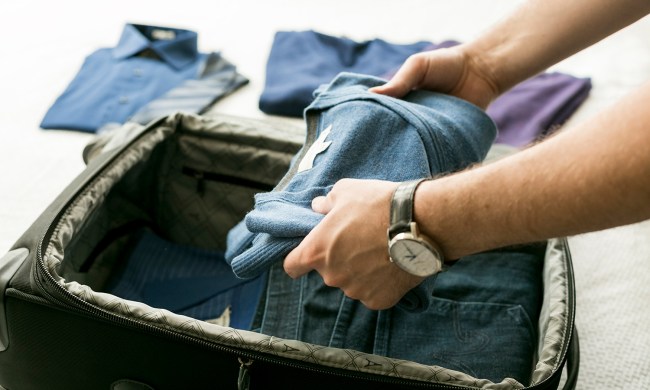When it comes to business travel, a solid packing list is as crucial as your itinerary. Whether you’re headed out for a few days of meetings or an entire week of conferences, packing efficiently ensures you’re ready for anything the trip throws at you. Here’s a business trip packing list with tips to help keep your business travel smooth, light, and hassle-free.
1. Clothing essentials

Packing for a business trip requires careful planning, especially if your agenda is packed. Here’s a streamlined list of wardrobe essentials that will keep you looking sharp and feeling comfortable:
- Business attire: Pack a versatile suit (or two) that you can mix and match with different shirts. Darker colors are typically better for business travel, as they’re less likely to show wrinkles or stains.
- Dress shirts: Bring one for each day, plus an extra, in case of spills or last-minute evening events.
- Comfortable shoes: Consider classic oxfords or loafers that work with both business and smart-casual looks.
- Casual attire for downtime: If you have time off, a simple outfit like jeans and a T-shirt will help you relax and explore after hours.
For longer trips, using a dry-cleaning service at the hotel can help keep your wardrobe fresh without overloading your luggage.
2. Personal care essentials

A well-prepared toiletry bag can be a lifesaver on a business trip, especially when the days start early and end late. Here’s what you need for a tidy, travel-friendly setup:
- Travel-sized toiletries: Go for the essentials – shampoo, conditioner, body wash, toothpaste, and deodorant. For liquids, make sure they comply with TSA’s 3-1-1 rule if you’re carrying them on board.
- Personal grooming kit: Include a razor, comb or brush, nail clippers, and any skincare products you use daily. Plus, a beard trimmer or electric shaver can come in handy.
- Medication: If you’re on any prescription medications, bring enough for the entire trip, plus a few extra days’ worth in case of delays.
A well-organized toiletry bag will make it easier to breeze through airport security and stay fresh, even if your schedule doesn’t leave time for a long morning routine.
3. Technology and work essentials

Business travel typically demands a mini office on the go. Here are some tech must-haves to keep you productive and connected:
- Laptop and charger: A given for most work trips. If you have to go from meeting to meeting, consider a laptop sleeve for easy portability.
- Smartphone and charger: Keep your charger handy, or better yet, bring a power bank to ensure you’re not left scrambling for an outlet.
- Portable Wi-Fi hotspot: If you’ll be in areas with unreliable Wi-Fi, a personal hotspot can be a lifesaver for staying connected and productive.
- Notepad and pen: You’d be surprised how often you may reach for this during travel. A small notepad and pen are also helpful for jotting down ideas or notes between meetings.
- Business cards: If you’re meeting new clients or networking, a few business cards will help you make a lasting impression.
Consider packing all tech gear in a dedicated tech organizer so cables, chargers, and small items don’t get lost in your bag.
4. Travel essentials

Smooth travel is all about preparation. The following items make a big difference when you’re on the move:
- Travel-friendly briefcase or backpack: Your work bag should be durable, spacious, and easy to carry. Look for something with enough compartments to organize your laptop, chargers, and paperwork.
- Noise-canceling headphones: Perfect for focusing on work during a flight or blocking out noise at a busy airport.
- Portable battery pack: Essential for when outlets are few and far between, especially in transit. A fully charged battery pack can power up your phone, laptop, or other essentials when you need it most.
- Reusable water bottle: Staying hydrated is key, especially when flying. Bring a refillable water bottle to cut down on single-use plastics and avoid paying for bottled water at the airport.
5. Extras for comfort

Long days and extensive travel can be exhausting. Here’s how to pack for comfort:
- Travel pillow: A small travel pillow can make all the difference on long flights.
- Compression socks: These help with blood circulation during long flights and reduce the risk of swelling or discomfort.
- Eye mask and earplugs: For overnight flights or red-eyes, an eye mask and earplugs can help you arrive at your destination well-rested and ready to go.
6. Documents and important information

Organizing your documents will save you from fumbling through your bag at check-ins and meetings:
- Passport or ID: Depending on your destination, don’t forget your ID or passport, along with any required visas.
- Itinerary and contact information: Have a printed copy of your itinerary, hotel reservation, and important contacts. Many people rely on digital versions, but printed copies can be useful in case of low battery or other tech issues.
- Expense tracking system: Whether it’s an app, notebook, or receipts folder, keep a record of your expenses to make reimbursement easy when you return from your business trip.




